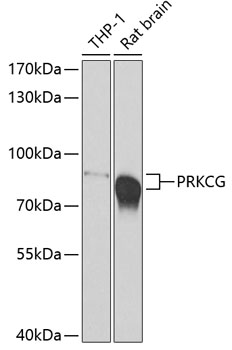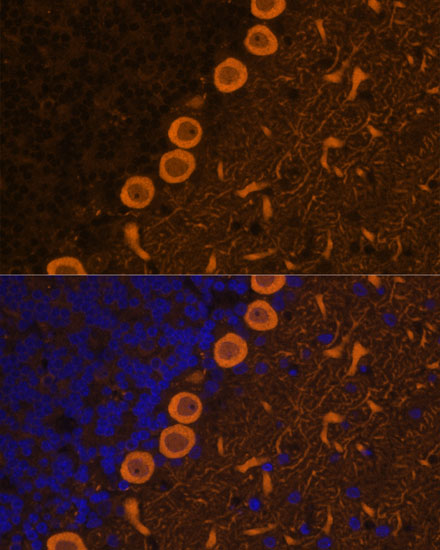Cell Biology Antibodies 11
Anti-PRKCG Antibody (CAB7922)
- SKU:
- CAB7922
- Product Type:
- Antibody
- Reactivity:
- Human
- Reactivity:
- Mouse
- Reactivity:
- Rat
- Host Species:
- Rabbit
- Isotype:
- IgG
- Antibody Type:
- Polyclonal Antibody
- Research Area:
- Cell Biology
Description
| Antibody Name: | Anti-PRKCG Antibody |
| Antibody SKU: | CAB7922 |
| Antibody Size: | 20uL, 50uL, 100uL |
| Application: | WB IF |
| Reactivity: | Human, Mouse, Rat |
| Host Species: | Rabbit |
| Immunogen: | A synthetic peptide of human PRKCG |
| Application: | WB IF |
| Recommended Dilution: | WB 1:500 - 1:2000 IF 1:50 - 1:200 |
| Reactivity: | Human, Mouse, Rat |
| Positive Samples: | THP-1, Rat brain |
| Immunogen: | A synthetic peptide of human PRKCG |
| Purification Method: | Affinity purification |
| Storage Buffer: | Store at -20'C. Avoid freeze / thaw cycles. Buffer: PBS with 0.02% sodium azide, 50% glycerol, pH7.3. |
| Isotype: | IgG |
| Sequence: | Email for sequence |
| Gene ID: | 5582 |
| Uniprot: | P05129 |
| Cellular Location: | Cell junction, Cell membrane, Cell projection, Cytoplasm, Peripheral membrane protein, dendrite, perinuclear region, synapse, synaptosome |
| Calculated MW: | 62kDa/78kDa |
| Observed MW: | 78kDa |
| Synonyms: | PRKCG, PKC-gamma, PKCC, PKCG, SCA14 |
| Background: | Protein kinase C (PKC) is a family of serine- and threonine-specific protein kinases that can be activated by calcium and second messenger diacylglycerol. PKC family members phosphorylate a wide variety of protein targets and are known to be involved in diverse cellular signaling pathways. PKC also serve as major receptors for phorbol esters, a class of tumor promoters. Each member of the PKC family has a specific expression profile and is believed to play distinct roles in cells. The protein encoded by this gene is one of the PKC family members. This protein kinase is expressed solely in the brain and spinal cord and its localization is restricted to neurons. It has been demonstrated that several neuronal functions, including long term potentiation (LTP) and long term depression (LTD), specifically require this kinase. Knockout studies in mice also suggest that this kinase may be involved in neuropathic pain development. Defects in this protein have been associated with neurodegenerative disorder spinocerebellar ataxia-14 (SCA14). Two transcript variants encoding different isoforms have been found for this gene. |
| UniProt Protein Function: | PKCG: a calcium-activated, phospholipid- and diacylglycerol (DAG)-dependent serine/threonine-protein kinase. Expressed in the brain and spinal cord where its localization is restricted to neurons. Several neuronal functions, including long term potentiation and depression (LTP<D) specifically require this kinase. Knockout studies in mice also suggest that this kinase may be involved in neuropathic pain development. Defects have been associated with neurodegenerative disorder spinocerebellar ataxia-14. Plays diverse roles in neuronal cells and eye tissues, such as regulation of the neuronal receptors GLUR4 and NMDAR1, modulation of receptors and neuronal functions related to sensitivity to opiates, pain and alcohol, mediation of synaptic function and cell survival after ischemia, and inhibition of gap junction activity after oxidative stress. Binds and phosphorylates GLUR4 glutamate receptor and regulates its function by increasing plasma membrane-associated GRIA4 expression. In primary cerebellar neurons treated with the agonist 3,5-dihyidroxyphenylglycine, functions downstream of the metabotropic glutamate receptor MGLUR5 and phosphorylates NMDAR1 receptor which plays a key role in synaptic plasticity, synaptogenesis, excitotoxicity, memory acquisition and learning. May be involved in the regulation of hippocampal long-term potentiation (LTP), but may be not necessary for the process of synaptic plasticity. May modulate the functionality of mu-type-opioid receptors by participating in a signaling pathway which leads to the phosphorylation and degradation of opioid receptors. May also contributes to chronic morphine-induced changes in nociceptive processing. Plays a role in neuropathic pain mechanisms and contributes to the maintenance of the allodynia pain produced by peripheral inflammation. Plays an important role in initial sensitivity and tolerance to ethanol, by mediating the behavioral effects of ethanol as well as the effects of this drug on the GABA(A) receptors. During and after cerebral ischemia modulate neurotransmission and cell survival in synaptic membranes, and is involved in insulin-induced inhibition of necrosis, an important mechanism for minimizing ischemic injury. Required for the elimination of multiple climbing fibers during innervation of Purkinje cells in developing cerebellum. Is activated in lens epithelial cells upon hydrogen peroxide treatment, and phosphorylates connexin-43, resulting in disassembly of GJA1 gap junction plaques and inhibition of gap junction activity which could provide a protective effect against oxidative stress. Phosphorylates p53 and promotes p53-dependent apoptosis in response to DNA damage. Interacts with GRIA4. Interacts with CDCP1. Interacts with TP53INP1 and p53. Expressed in Purkinje cells of the cerebellar cortex. |
| UniProt Protein Details: | Protein type:Protein kinase, Ser/Thr (non-receptor); Protein kinase, AGC; EC 2.7.11.13; Kinase, protein; AGC group; PKC family; Alpha subfamily Chromosomal Location of Human Ortholog: 19q13.4 Cellular Component: cytosol; dendrite; intracellular; perinuclear region of cytoplasm; plasma membrane Molecular Function:calcium-dependent protein kinase C activity; protein kinase activity; protein kinase C activity; protein serine/threonine/tyrosine kinase activity Biological Process: negative regulation of neuron apoptosis; negative regulation of protein catabolic process; negative regulation of protein ubiquitination; peptidyl-serine phosphorylation; phosphorylation; platelet activation; positive regulation of mismatch repair; protein amino acid phosphorylation; regulation of circadian rhythm; regulation of response to food; response to morphine; response to pain Disease: Spinocerebellar Ataxia 14 |
| NCBI Summary: | Protein kinase C (PKC) is a family of serine- and threonine-specific protein kinases that can be activated by calcium and second messenger diacylglycerol. PKC family members phosphorylate a wide variety of protein targets and are known to be involved in diverse cellular signaling pathways. PKC also serve as major receptors for phorbol esters, a class of tumor promoters. Each member of the PKC family has a specific expression profile and is believed to play distinct roles in cells. The protein encoded by this gene is one of the PKC family members. This protein kinase is expressed solely in the brain and spinal cord and its localization is restricted to neurons. It has been demonstrated that several neuronal functions, including long term potentiation (LTP) and long term depression (LTD), specifically require this kinase. Knockout studies in mice also suggest that this kinase may be involved in neuropathic pain development. Defects in this protein have been associated with neurodegenerative disorder spinocerebellar ataxia-14 (SCA14). Two transcript variants encoding different isoforms have been found for this gene. [provided by RefSeq, Oct 2015] |
| UniProt Code: | P05129 |
| NCBI GenInfo Identifier: | 462455 |
| NCBI Gene ID: | 5582 |
| NCBI Accession: | P05129.3 |
| UniProt Secondary Accession: | P05129,B7Z8Q0, |
| UniProt Related Accession: | P05129 |
| Molecular Weight: | 62,030 Da |
| NCBI Full Name: | Protein kinase C gamma type |
| NCBI Synonym Full Names: | protein kinase C gamma |
| NCBI Official Symbol: | PRKCG |
| NCBI Official Synonym Symbols: | PKCC; PKCG; SCA14; PKC-gamma |
| NCBI Protein Information: | protein kinase C gamma type |
| UniProt Protein Name: | Protein kinase C gamma type |
| Protein Family: | Protein kinase |
| UniProt Gene Name: | PRKCG |
| UniProt Entry Name: | KPCG_HUMAN |








